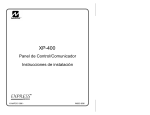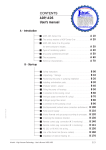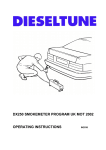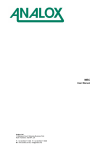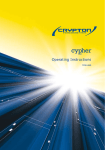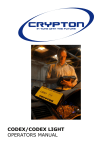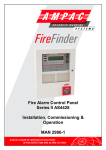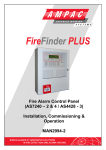Download 680 Emission Analyser Service Manual
Transcript
680 Emission Analyser Service Manual TES1567 Issue C June 2008 680 Emission Analyser Service Manual June 2008 TES1567 Issue C This page intentionally blank 2 of 36 680 Emission Analyser Service Manual June 2008 TES1567 Issue C CONTENTS THEORY OF OPERATION ........................................................................... 5 POWER SUPPLY ........................................................................................ 6 SAMPLING AND FILTRATION SYSTEM ...................................................... 7 Sampling Gas ........................................................................................... 7 Auto Zero ............................................................................................... 10 Calibration ............................................................................................. 11 POTENTIAL PROBLEMS AND CAUSES ...................................................... 12 Gas Flow Restricted................................................................................ 12 Leak Test Failure .................................................................................... 12 PROCESSING CIRCUITRY ....................................................................... 14 Processor PCB ........................................................................................ 14 Replacing the Processor PCB .................................................................. 15 OPERATION AND CONTROL .................................................................... 17 SERVICE MODE ....................................................................................... 20 Set-up Function ...................................................................................... 22 Replacing the Analyser ........................................................................... 25 IR BENCH ............................................................................................... 26 Bench Diagnostics .................................................................................. 27 Replacing the Bench ............................................................................... 28 Fault codes ............................................................................................. 29 List of Fault Codes .................................................................................. 30 TECHNICAL SPECIFICATIONS ................................................................. 31 APPENDIX 1 LIST OF ICONS ................................................................... 33 AFTER SALES SERVICE ........................................................................... 36 3 of 36 680 Emission Analyser Service Manual June 2008 TES1567 Issue C This page intentionally blank 4 of 36 680 Emission Analyser Service Manual June 2008 TES1567 Issue C INTRODUCTION The 680 is a microprocessor controlled exhaust gas analyser employing nondispersive Infra Red (NDIR) measuring techniques, and designed primarily for the legislative MOT test on petrol/CNG/LPG vehicles. The unit measures Carbon Monoxide (CO), Hydrocarbons (HC) and Carbon Dioxide (CO2). A further channel Oxygen (O2) is measured using a chemical cell. A fifth compound, Oxides of Nitrogen (NOx) is available as an option. The unit automatically compensates for zero drift by performing a zero check 5 minutes, 15 minutes and every 30 minutes thereafter from switch on. THEORY OF OPERATION Non-dispersive infrared spectrometry relies on the way different gases absorb infrared radiation at specific frequencies (see fig 1.). The amount of radiation absorbed can be used to calculate the concentration of a sample gas. The sample gas is passed through the sample cell where an infrared source is positioned at one end and an array of detectors at the other. Placed just in front of the detector array is a series of filters, designed to be transparent only to the selected frequencies of radiation. This arrangement allows the concentrations of several gases to be determined. Fig 1 Absorption Spectra 5 of 36 680 Emission Analyser Service Manual June 2008 TES1567 Issue C POWER SUPPLY – PWRS0026 There is a 65W multi-rail switched mode power supply providing power for the analyser. Input range is 100 – 240V AC, 50/60Hz and no adjustments are necessary within this range. The DC outputs are: +5V ±0.25V +12V ±1.0V -12V ±1.0V The outputs can be measured at the power connector of the processor bd SK4 as shown in fig 2. For part number see TES1601 PSA80504 SK4 0V -12V +5V +12V Fig 2 Power Supply Connections Power for the processor is derived from the +5V rail. The IR bench, pump and solenoid are driven from the +12V rail. The -12V rail is used solely for the amplifier of the pressure transducer and for RS232 communications when fitted. The Processor board requires programming according to the specific customer requirements. See appendix 2 for further details 6 of 36 680 Emission Analyser Service Manual June 2008 TES1567 Issue C SAMPLING AND FILTRATION SYSTEM The sampling system comprises a sample probe with 8.5m hose, 12V DC dual headed pump, 3 stage filtration system and changeover solenoid for use when the analyser is performing a routine zero function. Please refer to Fig. 4 and drawings AS09121 and AS08754 for details and part numbers of the pneumatics components. Sampling Gas Please refer to Figs 3 & 4. Gas is drawn from the vehicle exhaust by means of the pump, via the sample probe, hose and filtration system. The gas flow at the sample inlet of the analyser, given clean filters, is around 8L/min. On UK analysers there is a preconditioning water trap (shown below) fitted to the host trolley. There is no filter in this trap, its purpose is to help to cool the sample and remove a large proportion of the water vapour before it reaches the analyser. From there, the sample is passed through a dual bowl filtration system. The first bowl consists of a primary filter and water trap. Residual moisture is separated from the gas in this bowl and the condensed liquids are removed from the bottom of the bowl by the liquid head of the pump. There is a 75 micron nylon filter to remove the larger particulates and a pump filter to prevent contamination of the liquid head. The dry gas is then passed through the gas filter bowl which houses a 0.6 micron filter to remove the residual contaminants. This is followed by a bench filter which is fitted purely to prevent contamination of the bench and internals in the event of failure of any of the external filtration components. From there, the sample passes through the changeover solenoid and gas head of the pump and then on to the IR bench. The cell for measuring oxygen is positioned in the exhaust tract of the sample. Preconditioning Water Trap Fitted to Host Trolley 7 of 36 680 Emission Analyser Service Manual Water Trap & Primary Filter (FILT0041) Zero Filter (FILT0029) Flow Transducer 1.5psi Check Valve June 2008 Gas Filter (FILT0040) Calibration Gas Port Pump Filter (FILT0048) Sample Inlet Processor Board 3psi Check Valve TES1567 Issue C IR Bench Changeover Solenoid Bench Filter (FILT0048) Water Outlet Oxygen Cell Sample Outlet Power Supply (underneath cover) Pump Gas head Pump Liquid head Fig 3 Components 8 of 36 680 Emission Analyser Service Manual June 2008 TES1567 Issue C IR bench (TRDU0134) For part number see TES1601 PSA80504 PSA80491 Processor Board Power Supply Unit (PWRS0026) Zero Filter 1.5 psi Check Valve (VALV0019) (FILT0029) Gas Head Autozero Port Liquid Head Pump (AS09287) Flow Transducer 3.0 psi Check valve (VALV0020) 1 Cal Gas Port 2 Changeover Solenoid (VALV0033) Approx 5 L/min Bench Filter (FILT0048) Approx 5 L/min Gas Filter Sample Inlet Water Trap & Primary Filter Oxygen Cell (TRDU0067) Pump Filter (FILT0048) Water Outlet From Sample Hose/Probe Sample Outlet (PFIT0010) Flow approx 8L/min Water Trap fitted to host trolley (FL5004A) Manifold (PFIT0049) Fig 4 Flow Diagram The Processor board requires programming according to the specific customer requirements. See appendix 2 for further details 9 of 36 680 Emission Analyser Service Manual June 2008 TES1567 Issue C For part number see TES1601 Cell Cell Fig. 4a Interconnection Diagram The Processor board requires programming according to the specific customer requirements. See appendix 2 for further details 10 of 36 680 Emission Analyser Service Manual June 2008 TES1567 Issue C Auto Zero The analyser performs regular zero operations to ensure continued accuracy. The time intervals between zeroes from switch on are: 5 minutes; 15 minutes; then every 30 minutes thereafter. A manual zero can also be performed from the ‘Tools & Setup’ menu. The analyser will also perform a zero if any of the gas channels drift negative by more than the Maximum Permissible Error (MPE). These are as follows: HC -12ppm CO -0.06% CO2 -0.5% O2 -0.1% When a zero is initiated, the changeover solenoid (see fig 4) is energized. Gas flow to the bench is changed from the filters and sample inlet to the autozero port via the Zero filter and 1.5 psi check valve. The vacuum of the pump is great enough to open the 1.5 psi valve but not the 3.0 psi one (both devices are one way valves). This ensures that clean air for the zero is pulled only through the charcoal filter. The purpose of this charcoal filter is to remove any residual ambient Hydrocarbons thus ensuring a more accurate zero. The zero routine consists of a 30 second purge to ensure that there is no sample gas left in the system followed by the zero command to the IR bench. This will typically take a further 10 seconds for the bench to respond. After the zero, the analyser will check the oxygen cell. Cell millivolts at this point must be within 5 – 13mV for the cell to pass. This is followed by temperature compensation of the pressure transducer. No operator intervention is necessary. Calibration When calibrating, the correct tag values must be entered. These are the gas bottle concentrations as shown on the bottle certificate. The sample cell pressure is also displayed at this point and should be checked to ensure that it is within ±20mbar of ambient. The analyser will then perform an Autozero as described above. After the zero, the calibration gas bottle should be connected to the Gas Cal port, and the bottle pressure set using a digital manometer to between 1350 and 1450mbar. It may be noted that the Calibration Gas Port uses the same changeover solenoid as the Autozero. The bottle pressure (when set correctly) is high enough to open the 3.0 psi valve but, at the same time, ‘reverse bias’ the 1.5 psi one and ensure that it stays shut. This forces calibration gas through the solenoid and pump head and thus on to the bench avoiding the filters and sampling system. The analyser will then perform a gas purge. This uses the oxygen cell to ensure that a calibration gas is actually present. Attempting to perform a calibration on ambient air may cause the bench to corrupt its internal memory settings thus rendering it inoperable. To prevent this, the oxygen reading must fall to 0.2% or less for the calibration to continue. There is a 120 second countdown at this point. If the limit is not reached within the countdown the calibration will fail. After the purge the calibration command will be sent to the IR bench. No operator intervention is necessary. Following the calibration, the gas must be connected to the sample inlet and the pressure set to the ambient reading. The analyser will then check that the readings are within ±3% of the entered tag values as set by the legislation. Again, the oxygen cell is used to check for the presence of the calibration gas. The limit is 0.1% to allow for the ‘beating effect’ of the pump. This check also has a 120 second countdown. Failure to reach the limit will result in failure of the calibration. 11 of 36 680 Emission Analyser Service Manual June 2008 TES1567 Issue C POTENTIAL PROBLEMS AND CAUSES Gas Flow Restricted Restriction of the gas to the point where the flow at the inlet is 4L/min or less. The flow transducer (see fig. 4) continuously monitors the ‘vacuum’ after the filters to ensure that the flow is at a reasonable level and response time of the analyser is not too badly affected by contamination/blocked sample pipe etc. The output of the transducer is in volts and when the vacuum reaches a predefined point, set up on production and usually between 1.5 and 2.5V (refer to test specification TS1292 for set up procedure), the analyser will trigger a ‘Gas Flow Restricted’ message. Common causes: Heavily contaminated filters or blocked sample hose/probe. Another possible, but much less likely cause is the incorrect setting/failure of the flow transducer and associated circuitry. Check(s) Disconnect sample hose from analyser. If problem cured, blow out hose/probe assembly with airline. Inspect flexible probe end for damage/kinks. Unscrew filter bowls. If problem cured, replace filters. The nylon filter may be washed with warm soapy water. DO NOT USE SOLVENTS. Ensure no kinking or pinching of pipe work. Select ‘Information’ page. Check pneumatics settings and ensure that that: Flow Vacuum Limit between 1.5 & 2.5 Zero & Calibration Vacuums between 0.3 and 0.5 Leak Test Failure During normal operation, the 680 forces a leak test every day from switch on. One of the most common faults in a gas analyser is failure of this test. Common causes: Faulty joints, particularly in sample probe/hose assembly and between the two filter bowls. Damaged 'O' ring seals of filter bowls, particularly if filters have just been changed. Occasional contamination in liquid head of pump preventing the valves from closing correctly. Check(s) The test is performed in two parts: I. Threshold test II. Leak test The threshold test is performed to ensure that the pump is in reasonable condition and is actually running. When a leak test is performed, the PC will run the pump for 20 seconds to allow the vacuum to stabilise. At the end of this 12 of 36 680 Emission Analyser Service Manual June 2008 TES1567 Issue C period the output of the pressure transducer is checked to see if it is above the 3V limit shown on screen. This is a generic limit common to all 680 analysers. After the threshold test, the pump will be turned off and the vacuum voltage monitored for a further 10 seconds. The leak test limit is dynamic and will change depending on the performance of the pump. The limit is 95% of the final value and is shown on the screen. Check(s) • Pump operation. Is the pump actually running? Ensure that there is a flow of at least 6L/min at the sample inlet. • Disconnect and retest. If problem cured, inspect joints for leaks/damage. Also ensure flexible probe is not damaged. In cases of extreme exhaust gas temperature the p.t.f.e liner may melt and cause leak test failure. Sample probe/hose assembly (SP8) Check flexible p.t.f.e liner inside braiding. Replace the flexible probe end if necessary (SP8X). Check joints • • If the test still fails, ‘pinch off’ the pipe immediately after the gas filter bowl (see below) and retest. If problem cured, check all joints on sample inlet and filter bowl assembly, particularly the bowl to bowl adapter. Unscrew filter bowls and ensure the 'O' rings are in good condition and have not been 'pinched' during assembly. Check joints Pinch off pipe here Check ‘O’ rings (SEAL0036) Check joints 13 of 36 680 Emission Analyser Service Manual June 2008 TES1567 Issue C PROCESSING CIRCUITRY Processor PCB Refer to drawing AS09094 for schematic and layout of PCB. The 680 is controlled entirely by the PC. No autonomous functions are performed within the module. The PC communicates with the module via a USB link. Commands are sent over the link to a small processor bd which interprets them and communicates with the IR bench via an RS232 link. The processor board consists of an 18F series 'PIC'. There is a real time clock (RTC) on board which is used for calibration dates, leak test etc. When the module is powered, LED D4 (See fig 5) will flash once per second. This is driven by the RTC and a processor ‘interrupt’ and indicates that the processor core is healthy and functioning. When there is communication between the computer and the module, LEDs D5 and D6 will flash rapidly. These are the ‘communications’ LEDs. When the computer application is started, it will force the module to perform an autozero and then display ‘Main Menu’ (control and operation will be discussed later in this manual). While in Main Menu, the application will poll the module every 2 seconds to check its status. This can be seen by D5 and D6 flashing briefly. If an autozero is required the computer will automatically initiate it. LED D7 is not currently used. D5 & 6 Communications D4 Processor Healthy R7 Offset R9 Gain Pump & Solenoid drivers Fig 5 Processor PCB 14 of 36 680 Emission Analyser Service Manual June 2008 TES1567 Issue C Pump and Solenoid drive is achieved via two ‘MOSFET’ transistors TR1 and TR2. All Data and Program memory on the board is held within the Processor. This device is ‘electrically erasable’ so reprogramming the analyser can be performed by the host PC via the serial link. Communications to the bench are through the RS232 device IC6 and the 20 way connector SK6. The bench also obtains power from the 12V rail through this connector. Replacing the Processor PCB WARNING: Always ensure that the correct antistatic precautions are taken when handling the Processor PCB. The board is secured to the chassis by 3, M3 screws (see fig 6 below). Carefully note positions and orientation of the bench, power supply, solenoid and pump connectors and disconnect them. Disconnect the 4mm silicone vacuum pipe from P2 of the vacuum transducer. Undo and remove the three fixing screws. The PCB may then be removed from the analyser. Refitting is the reverse of the removal procedure Coloured tracer Denoting Pin 1 Bench Connector SK6 Fixing screw Power Connector SK4 Solenoid Connector SK2 Pump Connector SK1 Vacuum Pipe Fixing screws Fig 6 PCB Fixings 15 of 36 680 Emission Analyser Service Manual June 2008 TES1567 Issue C After replacing the PCB it will be necessary to perform some basic set up functions. These include setting the flow limits, serial number and performing a calibration to ensure that the recalibration date is set. Refer to the 'SET-UP Function' procedure in the ‘Service Mode' section for further details. Note: If the PCB has previously been used in another analyser, a problem may be encountered with the audit log stored on the PC. 16 of 36 680 Emission Analyser Service Manual June 2008 TES1567 Issue C OPERATION AND CONTROL As previously stated, from start up, the application will first perform an autozero. After the zero the ‘Main Menu’ is displayed. Legislative and market variations affect only the language and, in some cases, the inclusion of a ‘legislative procedure’ icon. Fig 7 below shows the difference between the basic MID (Measurement Instruments Directive) compliant analyser and the UK Analyser which must include the MOT procedure. All operations are performed using the icons in the toolbar on the right hand side of the screen. UK Legislative Procedure Fig 7 Main Menu A description of each icon is displayed by holding the mouse cursor over that icon. For a list of all icons refer to Appendix 1. 17 of 36 680 Emission Analyser Service Manual June 2008 TES1567 Issue C Selecting the ‘Information’ icon displays an ‘Information’ page (Fig 8) which includes details useful for basic diagnostic purposes. Fig 8 Information Page Included are details of program versions, pneumatics settings, calibration dates and a snapshot of the IR bench raw data (see section on IR Bench). A ‘Tools & Setup’ menu (Fig 9) is available from the ‘Main Menu’. This allows the user to perform other basic functions such as setting the time, performing a manual zero, performing a leak test etc. Service mode is also accessed from this menu. Fig 9 Tools & Setup 18 of 36 680 Emission Analyser Service Manual June 2008 TES1567 Issue C It is also possible to view the ‘Audit Log’ (Fig 10) from this screen. All analysers approved for sale in Europe from October 2006 must have an Audit Log which records updates/changes to the software plus the analyser serial number etc. Fig 10 Audit Log 19 of 36 680 Emission Analyser Service Manual June 2008 TES1567 Issue C SERVICE MODE Set up of the analyser is performed from the ‘Service Mode’. There are two methods of entering Service mode dependent on the legislative market. On UK analysers, an Authorisation code is required (Fig 11). Fig 11 Service Mode – Authorisation enable When the code is entered the service menu will automatically be displayed (Fig 12). The analyser will then stay in service mode until the ‘exit’ icon is selected. Fig 12 Service Mode 20 of 36 680 Emission Analyser Service Manual June 2008 TES1567 Issue C For Basic MID compliant analysers (i.e. those sold outside the UK), service activation is achieved by shorting the pins of LK2 on the processor board together (refer to Figs 13 & 14). When the pins are shorted, the analyser will automatically enter service mode and stay there until exit is selected. Fig 13 Service Mode - Jumper Enable Short pins of LK2 Fig 14 Service Jumper 21 of 36 680 Emission Analyser Service Manual June 2008 TES1567 Issue C SET-UP Function Test equipment required: Flow Gauge, 0-12 litres/min. Manometer, digital 0 - 2000mbar. Mixture gas comprising: 3.5% Vol CO Nom. 14.0% Vol CO2 Nom. 2000ppm Vol C3H8 Nom. Balance N2 Connect unit to mains supply and switch on. Time & Date Enter the ‘Service Mode’ (An Authorisation Code will be required), and select 'Date & Time'. Check that both the date and time are correct. If they are not correct then set the ‘date’ and ‘time’, confirm with ‘Continue’ then ‘Exit’. Oxygen Cell Select ‘Oxygen cell’. Ensure that the oxygen cell is correctly connected and then select 'Install new cell' to perform an installation. If unsuccessful, rectify the fault and then repeat the installation. Exit ‘Oxygen cell’. Flow Setup Connect the flow gauge to the sample probe inlet. Select ‘Live Readings’, check that the pump turns on and that a flow of greater than 6.0 L/min is present. Exit ‘Live Readings’, select ‘Oxygen cell’ and click ‘Retest’. This will force the analyser to perform an autozero. During the autozero, ensure that the flow at the sample inlet is less than 5.0 L/min and a flow is present at the inlet of the charcoal filter. Ensure that NO flow is present at the ‘cal gas port’. Disconnect the pipe to the pressure sensor and connect the digital manometer (ensure that the connection is gas tight). Block off the sample inlet and select live readings. Check that the reading on the manometer falls to less than 400mbar. Allow the reading to stabilise and note the final value displayed on the manometer. Exit ‘Live Readings’ and ensure that the pump turns off, wait 30 seconds and check that the reading has not changed by more than 20mbar of the final value displayed. If the reading changes by more than 20mbar, check the system for leaks, resolve & recheck. Disconnect the manometer and reconnect the pressure sensor. Select ‘Flow Setup’. Follow the on – screen instructions and adjust the ‘Offset’ using R7 and ‘Gain’ using R9 (see Fig. 5 - Processor Board). Note: This is an iterative process and the program may repeat the settings. When ‘offset’ and ‘gain’ are acceptable, the program will then display the instruction to attach the flow gauge. Set the flow to 4.0 L/min ±0.25L/min. With the correct flow set, select ‘continue’, this will set the low flow limit. Exit Service Mode. Return to ‘Main Menu’ and select ‘Information’. 22 of 36 680 Emission Analyser Service Manual June 2008 TES1567 Issue C Check the ‘Pneumatics’ settings and ensure that the ‘Flow Vacuum Limit’ is between 1.50 - 2.50 and both ‘Zero Vacuum’ and ‘Calibration Vacuum’ readings are between 0.30 – 0.50. Exit ‘Information’ and select ‘Leak Test’. Ensure ‘Leak Test’ passes. Gas Calibration Select gas ‘Calibration'. Using a digital manometer, check the displayed ‘Sample Cell Pressure (mbar)’ is correct to within ±20mbar of ambient. Enter the gas tag (concentration) values, recorded on the calibration gas bottle certificate being used. When completed, select 'continue'. Connect the calibration gas mixture to the ‘Cal.gas’ port. DO NOT TURN ON THE GAS. The analyser will perform an auto zero and then display 'open gas bottle'. Turn on the gas, with the bottle pressure set to 1400mbar ±50mbar and select 'continue'. The analyser will then perform a calibration, with no operator intervention required. Should the calibration fail due to a mismatch of the gas tag values and the actual concentration, the calibration must be repeated after rectifying the fault. Return to main menu. Select 'Live Readings', the analyser will display readings and the pump will be running. Check that the readings are within the following limits: CO CO2 HC O2 <= 0.02% <= 0.10% <= 6 ppm = 20.9% ± 0.5% absolute. Connect flow gauge to sample probe inlet and ensure that a flow rate of greater than 6.0 L/min is present. Restrict the inlet flow to 3.0 L/min ±0.25L/min and ensure that the "Gas Flow Restricted" screen is displayed. Remove restriction and ensure that readings are displayed. Exit ‘Live Readings’ and disconnect the flow gauge. 23 of 36 680 Emission Analyser Service Manual NOTE: June 2008 TES1567 Issue C The IR bench uses a variable P.E.F. for improved accuracy. These are displayed on the 'Information’ page of the Analyser. Example: Gas used - 1945ppm Propane. PPM 800 2000 4000 P.E.F. 0.523 0.508 0.493 P.E.F. applied = 0.509 If the unit is a 4 gas analyser, proceed to ‘Setting the serial number'. If a 5 gas unit is required perform the following section to install the NOx cell. NOx Installation/Calibration (5 gas units ONLY) Cut ‘Link 1’ on the processor bd. Perform ‘Leak Test’; ensure that test passes before continuing. Ensure that the nitric oxide cell is correctly connected and then select 'Install new NOx sensor' to perform a NOx cell installation. If unsuccessful, rectify the fault and then repeat the installation. Connect nitric oxide sample gas to the CAL gas calibration port. DO NOT TURN ON THE GAS. Select NOx calibration, and if necessary, edit the gas tag values for the gas sample to be used. When completed, select 'Calibrate with tag values shown'. The analyser will display 'open gas bottle'. Set the bottle pressure to 1400mbar +/50mbar and select 'Press when done'. The analyser will perform a calibration, with no operator intervention required. Disconnect the calibration gas. Should the calibration fail, the installation and calibration must be repeated after rectifying the fault. Setting the serial number Enter the 'Service Mode' on WGTS3 and select '680Serial Number Update' Enter the analyser serial number as shown on the serial label on the front of the analyser and click 'Continue' This completes the Set up 24 of 36 680 Emission Analyser Service Manual June 2008 TES1567 Issue C REPLACING THE ANALYSER Legislation for the MID dictates that there will be an ‘audit log’ containing details of program versions\updates\calibrations\replacement analysers etc. held on the computer and viewable by the recognized authorities. Each time the program and the 680 are run together, WGTS3 performs an action to verify the audit log. This is achieved by comparing data from the analyser (including serial number/firmware version etc) with that stored in the audit log. A code corresponding to the current state of the audit log is then stored in the analyser. In each analyser supplied by Crypton this code is reset so that the program will recognize it as a replacement\new analyser and update the audit log with the new serial number. However, should an analyser be used that has not been reset, it will invalidate the audit log (see Fig 15) as the analyser serial number will not match that already stored in the log. It will then need entry to the Service Mode for rectification. Fig 15 Audit Log Invalid From service mode, select ‘Audit Log Diagnostics’. If an analyser has been used that has not been reset, the program will then prompt the operator to reset the serial number. The audit log will then be updated and normal operation restored. 25 of 36 680 Emission Analyser Service Manual June 2008 TES1567 Issue C IR BENCH The bench fitted to the 680 module is a Non Dispersive Infra Red (NDIR) type found in most automotive emission analysers. The bench uses the NDIR technique to measure CO, CO2 and HC. Oxygen and Oxides of Nitrogen (NOx) may also be measured by using electrochemical cells fitted externally to the bench. The 4 gas configuration measuring CO, CO2, HC and O2 is the most common found in Europe as there is no legislation concerning levels of NOx produced by a vehicle. The particular advantages of the bench in the 680 are its low power consumption (typically less than 0.75W), wide power supply range (8 – 42V DC) and fast warm up time (less than 60 seconds). The bench derives power and communications via the 20 way ribbon connector. Communications are via an RS232 link (see Fig 16 for connector pin out). Fig 16 Bench Connector Pins 1 – 5 and 17 are additional ‘user’ inputs and are not used. These pins are connected directly to ground at the processor board. Pins 6 – 13 and 15 are ‘user’ outputs and are not used. These pins are connected to ground via 4K7 resistors at the processor board. 26 of 36 680 Emission Analyser Service Manual June 2008 TES1567 Issue C Bench Diagnostics A diagnostics screen is available from the service menu. This screen displays ‘live’ raw counts from the bench along with extended error codes, sample cell temperature and pressure etc (Fig 17). Fig 17 Bench Diagnostics The raw channel counts are useful to determine if the bench is becoming contaminated. Should any or all of the counts fall to 20000 or less, the bench will flag a ‘low light’ warning and this will be displayed as a fault code (see section on fault codes). The counts should be checked before calibration to avoid a potential failure shortly after. If the counts for any of the channels are less than 25000, it would indicate that the bench is becoming contaminated and preventative action should be taken (i.e. service replacement). If all of the channels are low it may indicate possible flooding or a light source failure. 27 of 36 680 Emission Analyser Service Manual June 2008 TES1567 Issue C Replacing the Bench The bench is mounted above the power supply and is held by two rubber anti vibration mounts and M4 nuts. Gas is supplied to the bench directly from the output of the pump, however as the flow from the pump is too high, gas for the bench is ‘sampled off’ using a bypass with a 1mm orifice restrictor. WARNING: Always ensure that the correct antistatic precautions are taken when handling the IR Bench. To replace the bench, first disconnect the pipes from the inlet and outlet (see Fig 18). Then disconnect the 20 way ribbon from the left hand side. Disconnect ribbon Disconnect gas pipes Fig 18 Bench Connections Finally, unplug the Oxygen cell connector from underneath the bench processor board on the right hand side (Fig 19). Note: this connector may be glued into place with silicone adhesive to prevent disconnection during transit. The securing nuts may then be undone and the bench lifted clear. Replacement is the reversal of this process. Oxygen cell connector NOx connector 5 gas units only Fig 19 Oxygen Connector 28 of 36 680 Emission Analyser Service Manual June 2008 TES1567 Issue C Fault codes Failure of the bench is indicated by a set of fault codes. For instance, should the bench fail and/or stop communicating with the processor PCB, a Not Responding NR screen will be displayed (Fig 20). Fig 20 Bench Not Responding There are also a set of ‘Extended Errors’ which may be displayed. These are in the form of four Bytes of error codes (Byte0 to Byte3 left to right) and will be displayed as shown if Fig 21 below. Fig 21 Bench Fault Code 29 of 36 680 Emission Analyser Service Manual June 2008 TES1567 Issue C Code F0 on Byte0 indicates low light level on all IR channels. This is the type of code that would be expected if the bench had been flooded. List of Fault Codes BYTE 0 1 2 3 CODE (HEX) 10 20 40 80 F0 All Codes All Codes 01 02 08 10 20 40 80 DESCRIPTION Reference channel light level below operational specifications. Low HC light level during AUTOZERO. Low CO2 light level during AUTOZERO. Low CO light level during AUTOZERO. Low Light – All Channels during AUTOZERO. Not used Not used O2 signal <7mV during bench zero. O2 signal <3mV during bench zero. Hexane span fail during calibration Propane span fail during calibration CO2 span fail during calibration CO span fail during calibration NO span fail. 5 gas units only 30 of 36 680 Emission Analyser Service Manual June 2008 TES1567 Issue C TECHNICAL SPECIFICATIONS Measured Gas HC CO CO2 O2 Hydrocarbons Carbon Monoxide Carbon Dioxide Oxygen Ranges CO CO2 HC O2 0 0 0 0 to to to to 10 % 20 % 10000 25 % ppm Accuracy / Performance OIML R99 Class 0 HC CO CO2 O2 8 ppm HC 0.02% CO 0.30% CO2 0.10% O2 absolute or 5% of reading, whichever is wider. Resolution HC CO CO2 O2 1 ppm vol. 0.01 % vol. 0 1 % vol. 0.01 % vol. RPM 0 - 10,000 rpm with DIS/Wankel and 4 stroke selection Oil Temperature 0 – 120 °C Lambda Calculated using Brett Schneider formula. Resolution 0.001 Fuel type selection: Unleaded Petrol, L.P.G. or C.N.G. 31 of 36 680 Emission Analyser Service Manual June 2008 TES1567 Issue C Environmental Operating temp. Storage temp. +5 to +40 °C -20 to +55 °C Warm-up Time <60 seconds Response Time 11 seconds to 95% of final reading with 8 metre sample hose Flow Rate 8 litres/min nominal 5 litres/min minimum Operating Pressure 750 - 1100 mbar 1013 mbar nominal Power Requirements 100 - 240 volts AC, 50 - 60 Hz Power Consumption 60 watts maximum Size 343mm (13.5") W x 220mm (8.7”) D x 17Omm (7") H Weight 5.2kg 32 of 36 680 Emission Analyser Service Manual June 2008 TES1567 Issue C APPENDIX 1 LIST OF ICONS Exit from program or current test/page. Display context sensitive help. Starts the MOT procedure. Calls up a live display of gases, engine speed, oil temperature and calculated Lambda for test and repair operations. Information page. Contains data regarding software versions, serial numbers, pefs, calibration dates. Selects the next menu Returns to previous menu Next/continue Back/return Accept Cancel 33 of 36 680 Emission Analyser Service Manual June 2008 TES1567 Issue C Repeat Print Edit personal/garage header Add/delete testers Set/adjust time and date Auotzero Check/replace Oxygen Cell HC Residue test Leaktest Service Mode Audit Log Diagnostics 34 of 36 680 Emission Analyser Service Manual June 2008 TES1567 Issue C Calibration Flow Setup IR Bench Diagnostics Serial Number 35 of 36 680 Emission Analyser Service Manual June 2008 TES1567 Issue C AFTER SALES SERVICE Apart from the routine maintenance and adjustments stipulated in this manual the equipment must not be tampered with in any way. All further servicing must be carried out only by an engineer from an Authorised Agent. Failure to observe these conditions will invalidate the Guarantee. Helplines On-Site Service / Overhaul / Spare Parts If you require a Service Engineer to attend ON SITE, either due to an equipment fault, or for machine calibration, or if the equipment covered by this manual requires to be sent back for factory overhaul, or if you need spare parts, please contact our Product Support Helpline at the following number during normal office hours. Tel: 0845 634 9904 Fax: 0845 050 99363 Email: [email protected] A fully comprehensive Product Support Contract is also available which provides additional assistance with equipment technical support. Please contact Product Support on the above Helpline no. for further details. Call Crypton Helpline for details of local service agents. Overseas: Service abroad is provided by the agent from whom your equipment was purchased. Crypton provide information and contracts covering: Car Data, Fault Code Information, Diagnostic Information, Software Support Contracts, Software Updates & Accessories. 36 of 36




































